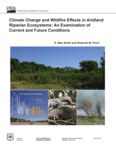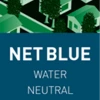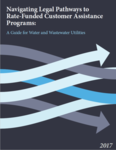Water and Birds in the Arid West: Habitats in Decline

Chad Wilsey, Taylor Lotem, Nicole Michel, Karyn Stockdale
National Audubon Society, July 2017
 As part of its Western Water Initiative, the National Audubon Society released a report, Water and Birds in the Arid Southwest: Habitats in Decline, which focuses on the Colorado River Basin and inland western saline lakes. The report assesses the impacts to key western bird species and their environments of the anticipated effects of climate change and water availability. Acting as a springboard for conservation actions, the report hopes to foster water management practices that take into account the surrounding ecosystem impacts. https://www.audubon.org/sites/default/files/wbaw_report_5july17_updated…
As part of its Western Water Initiative, the National Audubon Society released a report, Water and Birds in the Arid Southwest: Habitats in Decline, which focuses on the Colorado River Basin and inland western saline lakes. The report assesses the impacts to key western bird species and their environments of the anticipated effects of climate change and water availability. Acting as a springboard for conservation actions, the report hopes to foster water management practices that take into account the surrounding ecosystem impacts. https://www.audubon.org/sites/default/files/wbaw_report_5july17_updated…
Climate Change and Wildfire Effects to Aridland Riparian Ecosystems: An Examination of Current and Future Conditions

D. Max Smith, Deborah M. Finch
U.S. Department of Agriculture, U.S. Forest Service, Rocky Mountain Research Station, 2017.
In partnership with the U.S. Department of Agriculture, the U.S. Forest Service has published, Climate Change and Wildfire Effects to Aridland Riparian Ecosystems: An Examination of Current and Future Conditions, a study reviewing the ecohydrology of southwestern streams, particularly sites along the Middle Rio Grande, to describe the impacts of wildfires on plant communities and riparian-nesting birds. The study begins with a comparison of the ecohydrology among sites in the Colorado River and Rio Grande Basins to illustrate differences in streams. Next, the authors share their results from the Middle Rio Grande in New Mexico about the impacts to riparian recovery from the wildfires in 2011. Based on an examination of plant density and diversity in the area from Los Lunas to south of the Sevilleta fire, the study concludes that cottonwood forests are in decline. This change in composition will negatively affect the nesting-birds of the Middle Rio Grande, but further study is needed to better predict the quality of their habitat. Study outputs provide valuable information for setting standards for surface flows that ensure these ecosystems can remain healthy. The full report, RMRS-GTR-364, is only available online through Treesearch at www.treesearch.fs.fed.us/pubs/54331.
Net Blue Water Neutral Growth

Alliance for Water Efficiency, The River Network, and the Environment Law Institute
The Alliance for Water Efficiency partnered with the River Network and the Environmental Law Institute to create a model ordinance for communities to use in projecting and offsetting water demands of new developments. Such ordinances are intended to ensure that growth has a neutral impact on service area water demand. Users are able to access and amend the model ordinance based on local conditions. The model ordinance is free to use, user-friendly, and open source. http://www.allianceforwaterefficiency.org/net-blue-landing-page.aspx.
Navigating Legal Pathways to Rate-Funded Customer Assistance Programs

University of North Carolina at Chapel Hill Environmental Finance Center, July 2017
The University of North Carolina Environmental Finance Center released a report, Navigating Legal Pathways to Rate-Funded Customer Assistance Programs, on the financial burdens placed on low-income customers resulting from high water and wastewater rates. Utility rate hikes usually accompany infrastructure upgrades and may be needed to offset low per capita use. UNC provides profiles for each of the 50 states and describes the challenges to making customer assistance programs (CAPs) feasible and legally achievable. For Arizona, the report covers both commission-regulated (private) and noncommission-regulated (public) utilities. State statutes and policies mandate just and reasonable rates and prohibit any unfair advantage to any person, which may prevent utilities from offering lower rates to low income customers. However, Arizona offers a state-level bill assistance program based on income. The report also notes that Pima County offers a bill discount program, known as the Sewer Outreach Subsidy Program, to customers based on income. The report is available at https://efc.sog.unc.edu/sites/www.efc.sog.unc.edu/files/Pathways%20to%2….
Water Finance Clearinghouse

U.S. Environmental Protection Agency, Office of Water, Office of Wastewater Management, 2017.
The U.S. Environmental Protection Agency (EPA) recently introduced the Water Finance Clearinghouse, developed by the Water Infrastructure and Resiliency Finance Center. The Clearinghouse offers communities access to resources and funding opportunities through its online databases. Resources such as, case studies, reports, webinars, and presentations are available for communities to use when they are contemplating or making financing decisions about water infrastructure projects. The Clearinghouse “map” feature allows users to easily select a state, territory, or EPA Region for access to geographically relevant information. The portal was launched as an effort to create an all-inclusive database for community water finance needs. The Clearinghouse is updated on rolling basis and new resources and funding options can be submitted by becoming a Clearinghouse Contributor. To visit the Clearinghouse, go to https://ofmpub.epa.gov/apex/wfc/f?p=165:1::::::
Potable Reuse: Guidance for Producing Safe Drinking Water

World Health Organization, 2017. 
The latest release by the World Health Organization (WHO), Potable Reuse: Guidance for Producing Safe Drinking Water, builds upon previous WHO reports on potable reuse and safe drinking water quality in an effort to provide guidance for water suppliers, water managers, and those with an interest in potable reuse. Readers should be aware; however, that the report assumes that they are familiar with the safe drinking water framework. The report aims to provide information on potable reuse and its performance in current reuse schemes. WHO highlights case studies of potable reuse projects, either indirect or direct, intended to help fulfill identified water needs. Overall, the report provides an overview for those interested in adopting a potable reuse scheme. The report is available at http://www.who.int/water_sanitation_health/publications/potable-reuse-g…

